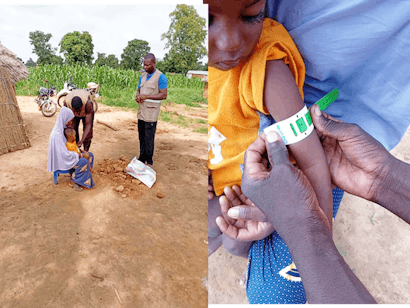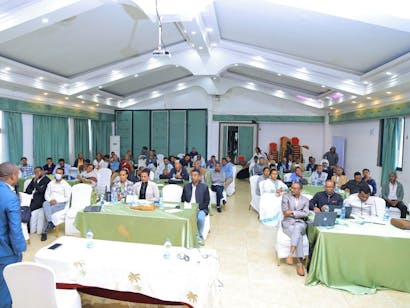Unveiling Gender Dynamics in Nutrition

CASCADE Capacity Building Interventions
Promoting gender equality and women’s empowerment is inseparably linked to the strengthening of food systems to fight hunger and malnutrition and improving the lives and livelihoods of rural populations. However, rural women continue to face multiple constraints that limit their productivity and undermine their capacity to overcome poverty that often leads to malnutrition. Unlike men, rural women typically have more limited access to and control over key productive resources such as land and technologies and to services such as credit and extension. They also encounter widespread inequalities in rural labor markets, forcing many to accept low-status, poorly paid jobs, without legal or social protection.
To address these inequalities, CASCADE Ethiopia conducted a gender analysis study to identify key gender issues contributing to gender disparities and malnutrition in the project intervention area. The study identified the key gender and social norms below that hinder nutrition security.
Gender Division of Labor: Household chores and childcare are traditionally seen as the responsibilities of women, while livelihood activities are considered the domain of men. This societal division often results in men refraining from participating in household chores and childcare tasks to avoid being labeled as ‘Setaset’ – which means ‘womanish’ in the community. Consequently, men’s involvement in household chores is limited to tasks such as fetching water and house maintenance. Women bear a heavier workload compared to men, spending 15 – 19 hours a day on household chores, childcare, and assisting in their husbands’ farming activities, whereas men typically work 5 – 12 hours. This unequal distribution of labor leaves women of reproductive age with insufficient time for self-care, nutritious meal preparation (especially during menstruation and pregnancy), attending ANC/PNC sessions, breastfeeding, and adopting healthier dietary practices. Furthermore, gender norms, values, and beliefs dictate food allocation and consumption within households, often prioritizing men and boys over women and girls in terms of both quantity and timing of food consumption, placing women at the bottom of the food hierarchy
Household Decision: Within the household, decisions made by the male head are unquestionably respected by women, boys, and girls. While women in the community typically decide how to utilize products from backyard gardening, such as vegetables, poultry, and poultry products, they frequently opt to sell these nutritious items rather than use them for household consumption. The proceeds are often used to purchase coffee, salt, and processed, low-quality or less healthy oil for household consumption.
Women have limited access to and control over productive assets: Despite the presence of policies, strategies, and implementation plans in government sectors aimed at influencing the collateral ownership and inheritance rights of women and men concerning productive assets such as land, farming equipment, livestock, and housing, gender norms, beliefs, and values persist. These norms often perpetuate the notion that only men are capable of effectively managing and administering larger productive assets. Consequently, women’s access to and control over such assets are restricted, limiting their ability to utilize them for the production, preparation, and consumption of healthier diets.
Food taboos: Food taboos, alongside poverty and climatic shocks like droughts, further compound challenges to accessing a diversified diet, particularly rich in protein from animal sources. These taboos, such as the belief that consuming the kidney and heart of sheep, goat, or cattle, or drinking goat milk, leads to tooth loss, and ‘eating the animal intestines eg cow’ results in emotional detachment and strained relationships with relatives, have significantly restricted dietary options for women, men, girls, and boys within households.
Access to Public Space and Services: Women’s participation in meetings and training sessions is disproportionately low due to various factors. Primarily, heavy household responsibilities impede their ability to attend such events. Additionally, entrenched gender norms, values, and beliefs contribute to their limited participation. Women often find themselves obligated to seek permission from their husbands to attend these sessions, viewing it as a gesture of respect and loyalty to their spouses.
Social Analysis and Action (SAA)
Social Analysis and Action (SAA) is a community-led process aimed at fostering social change. It enables individuals and communities to scrutinize and challenge prevailing social norms, beliefs, and practices concerning gender and sexuality that impact their lives. To spearhead this necessary transformation, CASCADE Ethiopia organized a five-day workshop, leveraging insights from a gender analysis study, to enhance the capacity of local government officials in utilizing SAA tools. These officials bear significant responsibility in collaborating with grassroots communities to effect change. The workshop encompassed various topics, including facilitation skills, situation analysis, monitoring techniques, minimum standards, norm prioritization, and other fundamental SAA tools.

Group presentation on problem tree
CASCADE
CASCADE employs multiple advocacy strategies, from sub-national to national and global levels, to strengthen policy implementation of nutrition-related policies. It draws on CARE’s and GAIN’s approaches, focusing on social accountability, good governance, health system strengthening, multisectoral coordination, resource mobilisation, private sector engagement and climate-resilient agricultural practices. It also strengthens community structures through community mobilisation and civil society engagement for collective pressure for changes in the food system. It collaborates with the SUN networks across six countries to address malnutrition. Gender, social norm transformation, and behaviour change (SAA) are cross-cutting strategies, both an essential goal and a means to magnify its impact.
Author
Atinkut Agegnehu
CARE Ethiopia, CASCADE Project
Policy and Advocacy Specialist.
©2024


